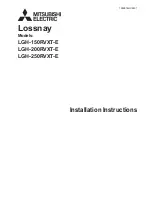
16
Baffle Filter Style Hoods
A. Exhaust:
With all the filters in place, determine the
total hood exhaust volume with a rotating
vane anemometer as follows:
1. All cooking equipment should be on.
. Measure the velocities
Velocity measurements should be
taken at five locations per filter. These
must be over a filter slot as in Fig. 1.
x
x
x
x
x
Rotating Vane Anemometer
Airflo
w
2
H/4
H/2
H/4
H
Fig. 1
A. To determine the proper dining room air balance:
1. Refer to engineering drawings to determine total exhaust CFM from dining areas.
(Exhaust fans, heating and air conditioning units, restrooms, etc.)
. Determine the total CFM of make-up air supplied to dining area.
3. Subtract #1 from # above. If the result is a negative number, a negative pressure is present
in the dining area. In this case, kitchen exhaust odors could be drawn from the kitchen to the
dining area. Therefore, exhaust or supply air should be adjusted to provide a slight positive
pressure in the dining area.
B. To determine proper kitchen air balance:
1. Refer to engineering drawings to determine total exhaust from the kitchen area.
(Exhaust hoods, dishwasher hoods, etc.)
. Determine total CFM of make-up air supplied to kitchen area.
(Make-up air hoods, heating and air conditioning units, etc.)
3. Subtract #1 from # above. The result should be a negative number. If the result is a positive
number, a positive pressure is present in the kitchen area. Kitchen odors could be forced into
the dining area. Also, a positively balanced kitchen area can adversely affect the performance
of the exhaust hood.
Caution: According to NFPA 96, Ch. 8-3 Replacement Air: Replacement air quantity shall be adequate
to prevent negative pressures in the commercial cooking area(s) from exceeding 4.98 kPa (0.0 in.
water column).
Balancing the Kitchen Exhaust System
Testing Hood Air Volume
















































